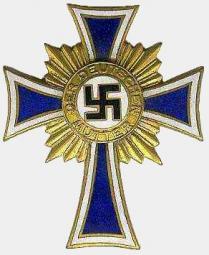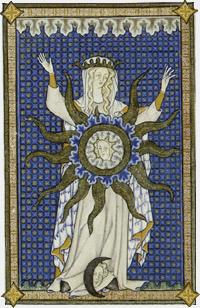Nazi “Mother's cross” and Maria cult
Hitler said that a woman's body belonged to the German people, while the Church claimed that it was the property of the Holy Ghost. Both meant that her body didn’t belong to her and should therefore be used to produce the maximum number of soldiers and/or Catholics. The mother's cross symbolised both the nationalistic and religious pressures to reproduce.
 This is a “Cross of Honour of the German Mother”, generally known as a “Mother's cross”, a fertility award in line with the policies of both the Nazis and the Church. It was intended as the feminine version of the iron cross for soldiers. (Note how the military cross has been elongated into a more Christian-looking one for the women.) The Nazis wanted more soldiers, the Church, more Catholics: here they were natural allies.
This is a “Cross of Honour of the German Mother”, generally known as a “Mother's cross”, a fertility award in line with the policies of both the Nazis and the Church. It was intended as the feminine version of the iron cross for soldiers. (Note how the military cross has been elongated into a more Christian-looking one for the women.) The Nazis wanted more soldiers, the Church, more Catholics: here they were natural allies.
The awards for fecundity followed the Olympic model (!): bronze for four children, silver for six and gold for eight. The children all had to be born alive, to be “genetically healthy” and of “German blood”. And if the mother ever behaved in a way which was “not in conformity with her race” she could be stripped of the award.
To make the decoration seem important it was to be worn only on special occasions. In this intensely status-conscious society, a bit of public recognition meant a lot to a housewife: the “Heil Hitler” greeting given her by members of the Hitler Youth, the preferential treatment when dealing with authorities and the seat offered her in public transportation and at mass rallies.
 Naturally, this use of women as baby machines was accompanied by much sentimentality. A Nazi slogan gushed: “Every mother with German blood shall be holy for us”. In this the Nazis imitated the Catholic cult of Maria, which served the same purpose. (Read about the pope’s use of the Virgin to boost fertility in The hallelujah weekend of Ireland.)
Naturally, this use of women as baby machines was accompanied by much sentimentality. A Nazi slogan gushed: “Every mother with German blood shall be holy for us”. In this the Nazis imitated the Catholic cult of Maria, which served the same purpose. (Read about the pope’s use of the Virgin to boost fertility in The hallelujah weekend of Ireland.)
However, beneath the flowery words, the public perks and the shiny trinkets lay cold calculation. The year before Germany started the war, the Nazis had already put this soldier-production project in place. Hitler's crude comparison was that the woman bleeds while given birth, and the man bleeds on the battlefield. Thus mothers were honoured in the name of the Fuehrer for committing their “bodies and lives” by bearing and raising children. Hitler called it “the women's battlefield”. Her service there was also termed "a holy duty” for the “motherhood crusade". Pope Francis urged the addition of “new children through Baptism, [so that] the Church grows”, and the Nazis were equally intent on the production new members for the German Reich.
The exploitation was justified by denying that a woman’s body was even her own. As the Nazis put it: “Your body doesn't belong to you, but rather to your family, and through your family, to your country [Volk]”. Or as the Church puts it, (citing St. Paul): “...Your body is the temple of the Holy Ghost...and ye are not your own”.
Related:
♦ Life at all costs
♦ Using abortion to ban contraception
Sources:
King James Version of the Bible, I Corinthians 6:19.
Liliane Leible, "Muttertag und 'Mutterkreuz': Zur Geschichte einer Ideologie", Stattzeitung für Südbaden, Ausgabe 45, 2001-02.
http://stattweb.de/cgi-bin/baseportal.pl?htx=/stattweb.de/ArchivDetail&db=Archiv&Id=440
Mitteldeutscher Rundfunk, "Mutterkreuz und Lebensborn", 15 March 2005.
http://essen.dhd24.com/azl/index.php?anz_id=7022924#zusatz
"Pope's Morning Homily: Marriage Should Reflect Christ's Fruitful Love for His Church", Zenit, 2014-06-02. http://www.zenit.org/en/articles/pope-s-morning-homily-marriage-should-reflect-christ-s-fruitful-love-for-his-church








 The Nazis and the German churches
The Nazis and the German churches